Goniothalamus expansus is a species of plant in the family Annonaceae. It is native to Thailand and Vietnam. William Grant Craib, the British botanist who first formally described the species, named it after its expanded stigmas.
Goniothalamus sawtehii is a species of plant in the family Annonaceae. It is native to Myanmar and Thailand. Cecil Ernest Claude Fischer the botanists who first formally described the species, named it in honor of Maung Saw Teh, a plant collector who provided the specimen examined by Fischer.
Goniothalamus tavoyensis is a species of plant in the family Annonaceae. It is native to Myanmar and Thailand. Debabarta Chatterjee, who first formally described the species, named it after a town in Myanmar that at the time was called Tavoy, but has since be renamed Dawei.
Goniothalamus tortilipetalus is a species of plant in the family Annonaceae. It is native to Peninsular Malaysia and Thailand. Murray Ross Henderson, the Scottish botanist who first formally described the species, named it after its twisted petals.
Pseuduvaria silvestris is a species of plant in the family Annonaceae. It is native to New Guinea. Ludwig Diels, the botanist who first formally described the species under the basionym Orophea silvestris, named it after the forested habitat the specimens he examined were found growing in near the Waria River.
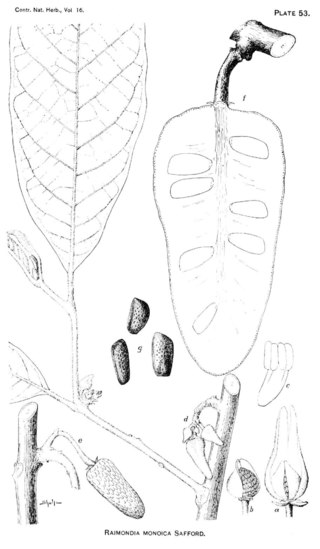
Annona cherimolioides is a species of plant in the Annonaceae family. It is native to Colombia and Ecuador. José Jerónimo Triana and Jules Émile Planchon, the botanists who first formally described the species, named it after its resemblance to another Annona species A. cherimoya.
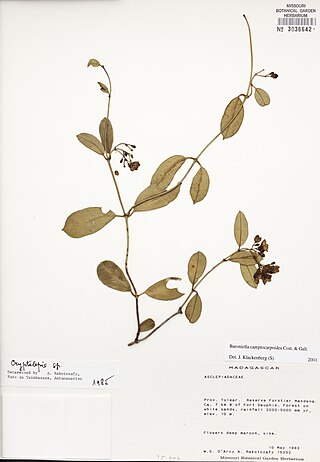
Baroniella camptocarpoides is a species of plant in the Apocynaceae family. It is endemic to Madagascar. Julien Noël Costantin and Ernest-Isidore Gallaud, the botanists who first formally described the species, named it after its resemblance to, but distinctiveness from, plants in the genus Camptocarpus.

Batesanthus pseudopalpus is a species of plant in the Apocynaceae family. It is native to the Republic of the Congo and Gabon. Hendrik J. T. Venter and Rudolf L. Verhoeven, the botanists who first formally described the species, named it after the lobes of its corona which they said resemble the pedipalps of the rain spiders Palystes castaneus and Palystes superciliosus.

Batesanthus purpureus is a species of plant in the Apocynaceae family. It is native to the Cameroon, the Central African Republic, Democratic Republic of the Congo, Gabon, Guinea, Ivory Coast, Liberia, and Nigeria. Nicholas Edward Brown, the botanist who first formally described the species, named it after its purple flowers.

Buckollia volubilis is a species of plant in the Apocynaceae family. It is native to the Ethiopia, Kenya, Somalia, Tanzania and Uganda. Rudolf Schlechter, the botanist who first formally described the species, named it after its twining growth habit, using the synonymous name Raphionacme volubilis.
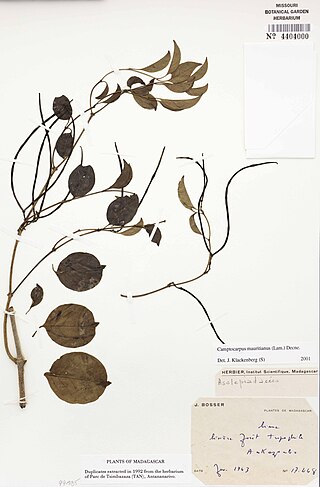
Camptocarpus mauritianus is a species of plant in the Apocynaceae family. It is native to Comoros, Madagascar and Réunion. Jean-Baptiste Lamarck, the naturalist who first formally described the species named it, using the synonym Cynanchum mauritianum, after the region of the Indian Ocean that includes the island of Mauritius, although the type specimen he examined did not list a specific location.
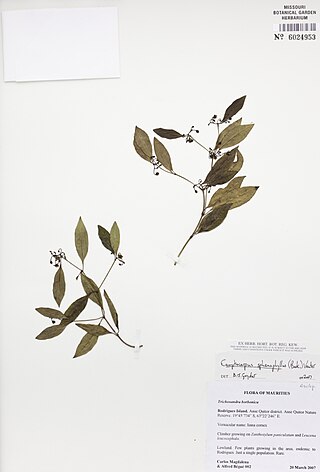
Camptocarpus sphenophyllus is a species of plant in the Apocynaceae family. It is endemic to the island of Rodrigues. Isaac Bayley Balfour, the naturalist who first formally described the species named it, using the synonym Tanulepis sphenophylla, after its wedge-shaped leaves.

Chlorocyathus lobulata is a species of plant in the Apocynaceae family. It is native to the Cape Provinces of South Africa. Hendrik J. T. Venter and Rudolf L. Verhoeven, the botanists who first formally described the species named it, using the synonym Raphionacme lobulata, after the distinctive lobes of the corona of its flowers.

Camptocarpus semihastatus is a species of plant in the Apocynaceae family. It is native to Madagascar. Jens Klackenberg, the botanist who formally described the species named it after the distinct coronal lobes of its flowers that resemble half the head of a spear.

Condylocarpon amazonicum is a species of plant in the Apocynaceae family. It is native to Bolivia, Brazil, Suriname, and Venezuela. Friedrich Markgraf, the botanist who first formally described the species, using the basionym Anechites amazonicus, named it after the area near the Amazon River in Pará Brazil where the specimen he examined was collected by Adolpho Ducke.

Condylocarpon guyanense is a species of plant in the Apocynaceae family. It is native to Brazil, French Guiana, and Guyana. René Louiche Desfontaines, the botanist who first formally described the species, named it after Guyana where Joseph Martin collected the specimen he examined.

Condylocarpon isthmicum is a species of plant in the Apocynaceae family. It is native to Argentina, Brazil, Paraguay and Uruguay. José Mariano de Conceição Vellozo, the botanist who first formally described the species, named it after the narrow neck connecting the two sections of its fruit.
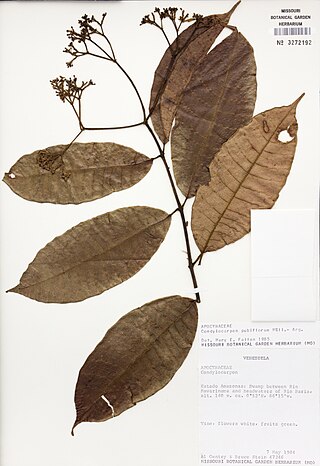
Condylocarpon pubiflorum is a species of plant in the Apocynaceae family. It is native to Bolivia, Brazil, Colombia, Peru and Venezuela. Johannes Müller Argoviensis, the botanist who first formally described the species, named it after an invalid nomen nudum, Hortsmania pubiflora, previously offered by George Bentham.
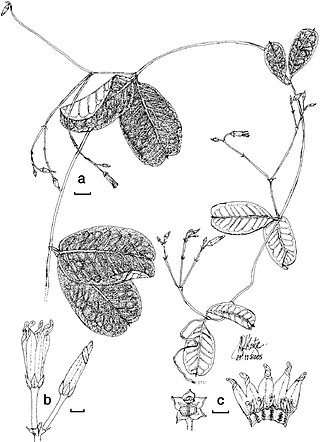
Cryptolepis africana is a species of plant in the Apocynaceae family. It is native to Kenya. Arthur Allman Bullock, the botanist who first formally described the species, using the synonymous subspecies name Cryptolepis sinensis subsp. africana, named it after the location where the sample he examined was collected in East Africa.
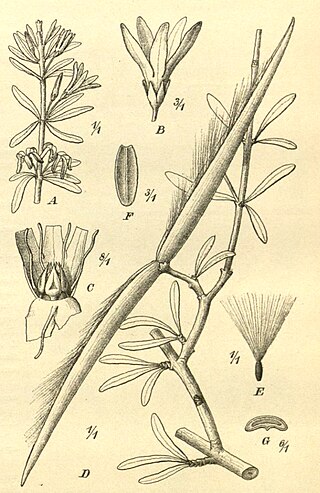
Cryptolepis decidua is a species of plant in the Apocynaceae family. It is native to Angola, Botswana, Namibia, and South Africa.















